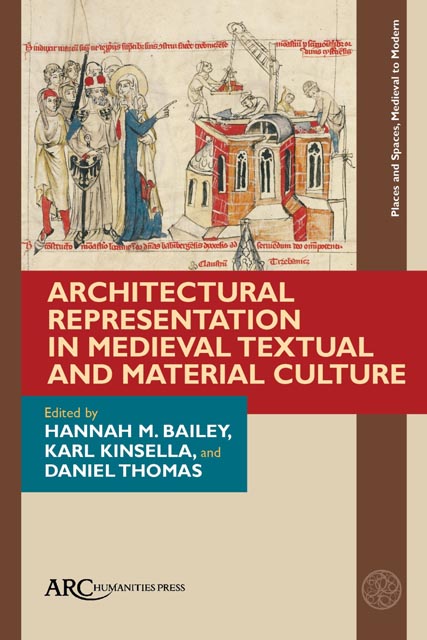Book contents
- Frontmatter
- Contents
- List of Illustrations
- Acknowledgements
- Introduction: Architectural Representation in Medieval Textual and Material Culture
- Chapter 1 Designing the Regensburg Spire and Harburg Tabernacle: The Geometries of Two Great German Gothic Drawings
- Chapter 2 Wilfrid’s Restoration of the Church at York and the Permanence of Sacred Buildings in Post-Conversion Northumbria
- Chapter 3 Heaven-Roofs and Holy Altars: Envisioning a Seventh-Century English Church in Aldhelm’s Carmina Ecclesiastica 3
- Chapter 4 “Beaten Down and Built Anew”: Saint Erkenwald and Old St. Paul’s
- Chapter 5 Castle Viewscapes in Literature and Landscapes
- Chapter 6 Architectural Alignment in Early Medieval English Settlements: Zoning, Meaning, and Function
- Chapter 7 Underneath the Arches: Peter of Eboli and the Orderly Architecture of Norman Sicily
- Chapter 8 Reading the Saint’s Church: A Northern Perspective
- Select Bibliography
- Index
Chapter 7 - Underneath the Arches: Peter of Eboli and the Orderly Architecture of Norman Sicily
Published online by Cambridge University Press: 16 November 2023
- Frontmatter
- Contents
- List of Illustrations
- Acknowledgements
- Introduction: Architectural Representation in Medieval Textual and Material Culture
- Chapter 1 Designing the Regensburg Spire and Harburg Tabernacle: The Geometries of Two Great German Gothic Drawings
- Chapter 2 Wilfrid’s Restoration of the Church at York and the Permanence of Sacred Buildings in Post-Conversion Northumbria
- Chapter 3 Heaven-Roofs and Holy Altars: Envisioning a Seventh-Century English Church in Aldhelm’s Carmina Ecclesiastica 3
- Chapter 4 “Beaten Down and Built Anew”: Saint Erkenwald and Old St. Paul’s
- Chapter 5 Castle Viewscapes in Literature and Landscapes
- Chapter 6 Architectural Alignment in Early Medieval English Settlements: Zoning, Meaning, and Function
- Chapter 7 Underneath the Arches: Peter of Eboli and the Orderly Architecture of Norman Sicily
- Chapter 8 Reading the Saint’s Church: A Northern Perspective
- Select Bibliography
- Index
Summary
Introduction: Sicilian Palimpsests
One of the truisms of writing on medieval Sicily is that its surviving archaeological and material remains can be taken as a kind of palimpsest, revealing layers of use and reuse by successive rulers, each attempting to put their stamp on the territory. Much has been written about Palermo, in particular, as a city that was made and remade according to the needs of different conquerors. Within my own period of specialism, the twelfth-century Norman kingdom of Sicily (1130–94) provides us with a wealth of complex buildings—the Cappella Palatina, the Zisa, the Cuba—whose significance has been expertly unpacked. Recent approaches have combined discussion of architecture, art, ecology, and horticulture. They have observed the debt owed by Norman building programs to other regions and models. It is with trepidation, then, that one approaches the task of saying anything new—at all—about the architecture of Norman Sicily. But most often that discussion has focused on what architectural features themselves represented—of water, of inscriptions, of gardens—rather than how architecture was represented in other media.
The following contribution aims to draw attention to an understudied area: the transition, in the final decade of the twelfth century, from Norman kingdom to Staufen kingdom. The Staufen emperor, Henry VI, claimed the right to the kingdom through his marriage to Constance, the surviving daughter of Roger II of Sicily (r. 1130–54). Just as we recognize the significance of architecture (and the use of space and place) to the self-expression of the twelfth-century Norman monarchy, we should—a necessary concomitant—examine how the role of architecture changed after the collapse of that monarchy, with the death of William II in 1189. Here we encounter a historiographical curiosity. We have a good (and ever-deepening) sense of what Norman rulers constructed up to 1189; we have some (though a far from complete) sense of what the later Staufen ruler of Sicily, Frederick II, built, from the 1220s onwards, but little attention has been paid to the “in between.” How should we configure the rule of Henry VI in Sicily: should this be seen as a break with Norman traditions, or a coda to them?
Some small part of that transition from Norman to Staufen rule can be understood through the representation of architecture and public space.
- Type
- Chapter
- Information
- Publisher: Amsterdam University PressPrint publication year: 2023



